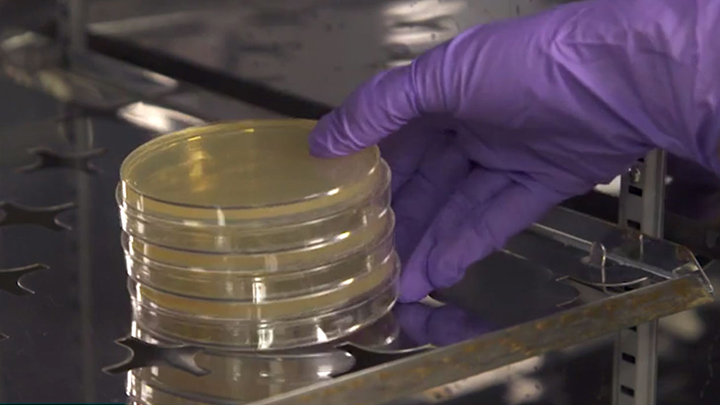Fast transformation plating with glass beads
Script
Please note that it is possible to autoclave beads after use. Here is a suggested method: Collect the used beads off the plates by pouring them into a funnel on top of a 250 ml glass bottle. When the bottle is full of beads, add distilled water. Cover and shake the bottle of beads. This loosens material clinging to the beads. At the sink, pour water/beads into a sieve, and rinse with more distilled water. Then rinse the beads with 70% alcohol. Spread the beads out on a paper towel placed on a raised edge tray overnight to dry. In the morning, pour the beads into smaller bottles for autoclaving.
Glass Bead Protocol
Using glass beads to spread outgrowth containing your transformants offers several advantages over conventional plating methods. It is easier and faster. It doesn't require an alcohol burner. And it results in consistent spreading of colonies over the surface of the plate. There may be a slight loss of efficiency, but the advantages outweigh this for most laboratory plating needs.
The beads are available in two sizes for plating, 2.5 mm and 4.5 mm-diameter beads. You can try both sizes to see which one you prefer, but they function equally well.
1. Start by adding 6 to 12 beads on either side of each plate.
2. Gently mix your outgrowth material by inverting three times and flicking the tube with your finger until the cells are uniformly distributed.
3. Gently pipette a dilution of outgrowth onto the center of your pre-warmed plate.
4. Place the plate on a folded paper towel square, up to four plates, each in two stacks, one for each hand.
5. The paper towel protects your laboratory bench surface from being scratched by the raised edges of the bottom plate. Vigorously move the plates forward and backwards. Make two complete 360 degree rotations, with stops every 90 degrees.
6. Let the plates sit for two minutes.
7. Pour off the beads into a beaker for recycling.
8. You are now ready to incubate your plates.
If you have any questions, our scientists are happy to help. Please contact us at info@neb.com or online at neb.com/techsupport.
Related Videos
-

How to Perform a Transformation with NEB® Competent Cells -

Tips for Successful Transformations with NEB® Competent Cells -

How Does the NEB® PCR Cloning Kit Work?

